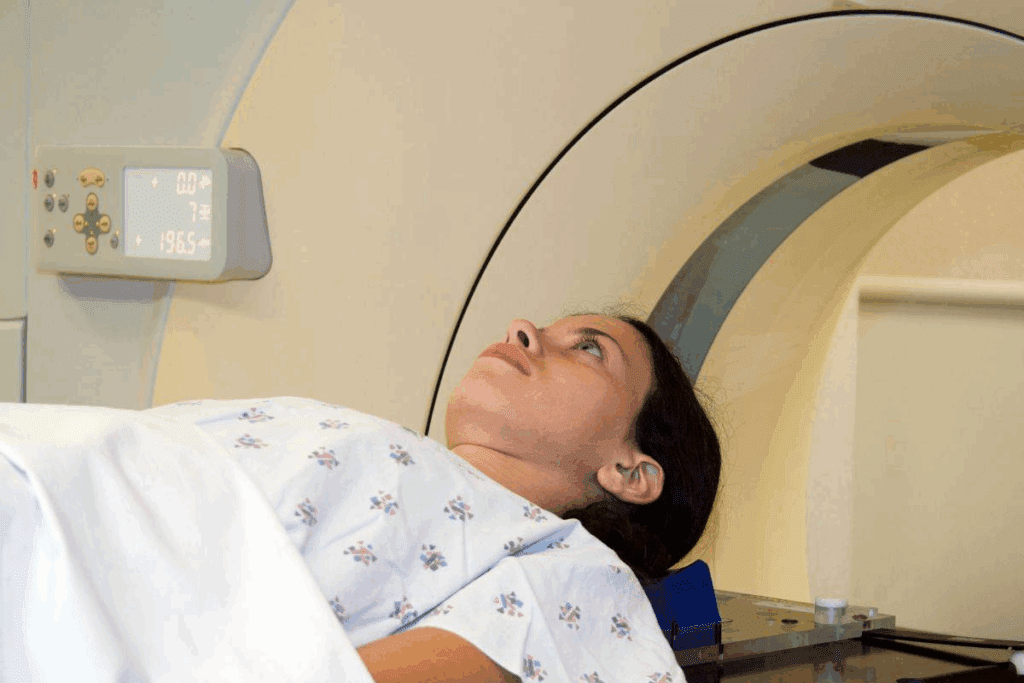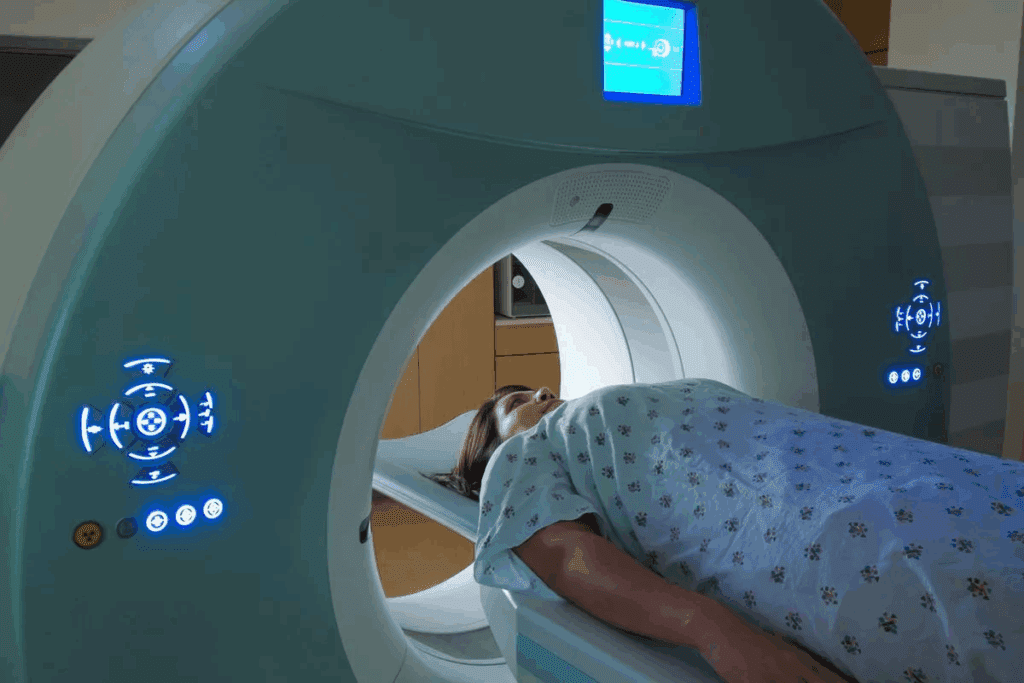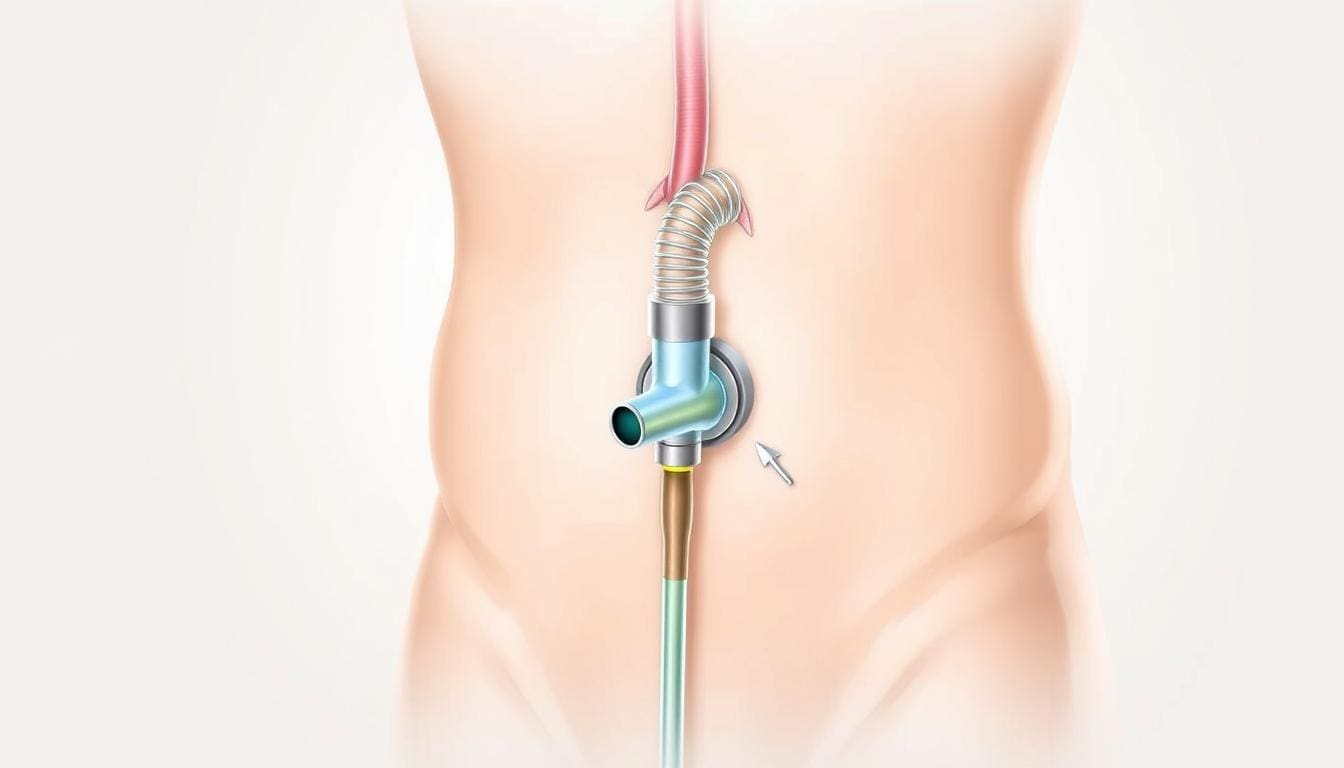Last Updated on November 27, 2025 by Bilal Hasdemir

Every year, 1.5 million people in the United States get a Positron Emission Tomography (PET) scan. This test is a key tool for doctors to find and treat different health issues.
So, what happens during a PET radiology scan? First, a tiny bit of radioactive material is injected into your body. This material lights up active areas in your cells.
This test shows how well your body’s organs and tissues work. It helps doctors make the best plans for your treatment.
Key Takeaways
- A PET scan is a diagnostic tool used to identify and manage various medical conditions.
- The procedure involves injecting a small amount of radioactive material into your body.
- PET scans provide valuable insights into the functioning of your body’s organs and tissues.
- The diagnostic imaging technique helps healthcare professionals develop effective treatment plans.
- Understanding what to expect during a PET scan can help alleviate anxiety and uncertainty.
Understanding PET Scan Technology and Its Purpose

It’s important to know how PET scans work for those going through this test. PET scan technology is key in medical imaging. It shows how the body’s cells work.
Definition and Basic Principles of PET Scans
A PET scan uses a special sugar molecule to find diseases like cancer. It’s based on the idea that cancer cells use more sugar than healthy cells. This makes cancer cells show up during the scan.
Common Medical Reasons for Ordering a PET Scan
PET scans are used to find and track cancer, check brain issues, and look at heart problems. They help doctors see how far a disease has spread. They also help in planning treatments.
| Medical Condition | PET Scan Application |
| Cancer | Diagnosis, staging, and monitoring treatment response |
| Brain Disorders | Assessing neurological conditions, such as Alzheimer’s disease |
| Heart Disease | Evaluating heart muscle viability and blood flow |
How PET Scans Differ from Other Imaging Tests
PET scans are different from MRI and CT scans. MRI and CT scans show detailed pictures of organs. But PET scans look at how tissues work, helping find diseases early.
PET Scan vs. Other Imaging Tests
- PET scans focus on metabolic activity, whereas MRI and CT scans focus on structural details.
- PET scans are great for finding cancer and seeing how it spreads.
- Using PET scans with CT or MRI scans gives a better view of diseases.
Preparing for Your PET Scan: Physical and Mental Readiness

To have a smooth PET scan, you need to prepare both physically and mentally. Getting ready is important for a good scan. It means following certain rules to make sure the scan works well and gives accurate results.
Dietary Restrictions Before the Procedure
Before a PET scan, you must follow certain diet rules. These rules help make sure the scan shows clear images. You might need to fast, avoid certain foods, or drink a special meal provided by the facility.
These rules help control your blood sugar and make sure the scan works right. High blood sugar can mess up the scan results.
| Dietary Restriction | Purpose | Duration |
| Fasting | Control blood sugar levels | 4-6 hours |
| Avoiding sugary drinks | Prevent interference with radiotracer uptake | 24 hours |
| Special meal or drink | Enhance radiotracer absorption | As instructed |
Medication Considerations and Instructions
Thinking about your medications is also key for PET scan prep. You need to tell your doctor about all your meds, including prescriptions and supplements. Some meds might need to be changed or stopped before the scan.
It’s important to follow your doctor’s or the facility’s instructions about your meds. This keeps the scan safe and effective.
Mental Preparation and What to Bring
Mental prep is as important as physical prep for a PET scan. Knowing what to expect can lower your anxiety and make the scan more comfortable. It’s good to ask questions and clear up any worries.
When you get to the facility, bring your insurance cards and ID. Also, bring things that make you feel comfy, like a blanket or pillow. Wear loose, comfy clothes too.
- Insurance cards and identification
- Comfort items (e.g., blanket, pillow)
- Loose, comfortable clothing
- Any prescribed medications
By following these tips, you can make sure your PET scan goes well.
Arriving at the Imaging Facility: First Impressions
When you arrive at the imaging facility for your PET scan, the atmosphere matters a lot. A clean and friendly place can make you feel less nervous about the test.
Check-in Process and Paperwork
First, you’ll check in at the reception desk. You’ll need to fill out some papers, like consent forms and medical history questionnaires. The check-in process is quick to keep wait times short. Make sure you have your ID and any medical records with you.
Initial Consultations with Medical Staff
Next, you’ll talk to the medical team. They will go over your medical history, explain the scan, and answer your questions. The medical staff are there to make you feel at ease, addressing any worries you have.
The Pre-Scan Environment and Setting
The waiting area is made to be cozy and calm. It might have seats, snacks, TVs, or books to take your mind off things. The staff will tell you when it’s time to go to the scanning room, getting you ready for the next part.
The first part of your visit to the imaging facility is key. Knowing what to expect at check-in, your talk with the medical team, and the waiting area helps you feel more ready and relaxed for the PET scan.
The Radiotracer Injection Experience
Learning about the radiotracer injection can ease worries during a PET scan. The radiotracer is key to the PET scan process. Knowing how it works can make the experience less scary.
What the Radiotracer Is and How It Works
The radiotracer in PET scans is a tiny amount of radioactive stuff. It’s attached to a molecule that the body absorbs in a certain way. For example, FDG (fluorodeoxyglucose) is often used to check how active tissues are.
When injected, the radiotracer moves through the blood. It builds up in areas with more or less activity. This helps doctors see what’s going on inside the body.
The PET scanner picks up the radiation from the radiotracer. It makes detailed pictures of the body’s inside workings. This info is key for diagnosing and tracking many health issues, like cancer and heart disease.
Physical Sensations During Injection
During the radiotracer injection, you might feel some things. The injection goes into a vein in your arm, like a blood test. You might feel a pinch or sting as the needle goes in, or you might not feel anything.
The injection is very quick, lasting just a few seconds. After it’s done, the needle comes out, and a bandage might be put on. Some people might get a little bruise or soreness, but it usually goes away quickly.
Common Immediate Reactions to the Radiotracer
Right after the radiotracer is given, some people might feel a bit different. You could feel warm or get a metallic taste in your mouth. These feelings usually don’t last long and don’t need medical help.
But, in very rare cases, some might have an allergic reaction. Signs can be itching, hives, or trouble breathing. It’s very important to tell your doctor about any allergies before the scan.
In summary, the radiotracer injection is a safe and important part of the PET scan. Knowing what to expect can make you feel more at ease and ready for your scan.
The Waiting Period: What Happens After Injection
After the radiotracer injection, a waiting period starts. This is key for the tracer to spread out in your body. It’s important for the PET scan to show your body’s metabolic activities.
Why Waiting Is Necessary for Tracer Distribution
The waiting time lets the radiotracer move and build up in certain areas. This buildup is critical for the PET scan to show clear images of your body’s metabolic processes. The time it takes can change based on the PET scan type and your health.
Physical Feelings During the Uptake Period
You might feel some physical sensations during this time. These can include feeling cold from the radiotracer or mild discomfort from side effects. It’s important to stay calm and not move much to help the tracer spread out evenly.
Activities Permitted During the Wait
Usually, you’re told to relax during the waiting period. Some places might let you:
- Read a book or magazine
- Listen to music or podcasts
- Use your phone or laptop (if allowed by the facility)
- Rest or take a short walk (depending on the facility’s rules)
It’s very important to follow the exact instructions from your healthcare provider or the imaging facility. Some activities might be off-limits to make sure the tracer spreads right and to prevent problems.
What to Expect When Entering the PET Scan Machine
Entering the PET scan machine can feel scary, but knowing what to expect helps. The machine is big and shaped like a cylinder. It’s made to take detailed pictures of your body.
Description of the PET Scanner Environment
The room for the PET scan is cool and a bit dark. This helps the machine work better. The machine itself is in a circle or doughnut shape.
The room has computers that watch over the scan. They make sure the pictures are clear. You’ll see safety features like emergency buttons and intercoms to keep you safe and comfy.
Positioning on the Scanner Table
You’ll lie down on a table that moves into the machine. A technician will help you get into the right spot. This makes sure the scanner gets the pictures it needs.
You might lie on your back, side, or stomach. It depends on what the scan needs. The technician will tell you exactly how to position yourself.
| Positioning Requirement | Purpose |
| Lying on your back | Allows for scanning of the torso and head |
| Lying on your side | Facilitates scanning of specific organs or areas |
| Lying on your stomach | Enables scanning of certain lower back or abdominal areas |
Initial Sensations When Entering the Machine
When you get into the machine, you might feel some things. It might be a bit cool or cold. You might also hear soft humming or whirring as it starts up.
It’s normal to feel a little scared or trapped. But the machine is made to be comfy. The scan itself doesn’t hurt.
Knowing about the PET scan machine and the process can make you feel more ready. It helps you know what to expect during your PET scan.
Physical Sensations During a PET Scan Procedure
When you have a PET scan, you might feel different things. This is because of the room and the need to stay very quiet. Knowing what to expect can help you get ready.
Temperature and Environmental Factors
The room for the PET scan is kept at a nice temperature. But, the table you lie on might feel a bit cool. There’s also a system to keep the air fresh and comfortable.
Environmental conditions during a PET scan are controlled to keep you comfortable. The room is kept between 68°F to 72°F (20°C to 22°C). This is a comfortable range for most people.
Noise Levels and Sounds You’ll Hear
The PET scanner makes some noise, but it’s not as loud as an MRI. You might hear soft beeping or gentle humming. These sounds mean the scanner is working right.
- Soft beeping sounds during the scan
- Gentle humming noise from the scanner
- Occasional clicking sounds during different stages of the scan
Body Sensations While Remaining Stil
Staying very quiet for a long time can be a bit hard. You might feel stiff or want to move. But, it’s important to stay as quiet as you can for good pictures.
| Sensation | Description | Mitigation |
| Stiffness | Feeling of stiffness due to prolonged immobility | Stretching before and after the scan |
| Discomfort | General discomfort from remaining silent | Adjusting position slightly if possible, or communicating with the technician |
| Coolness | Feeling cool due to the scanning table or room temperature | Using a blanket if provided |
Knowing about these physical sensations can help you prepare for the PET scan. This way, you can make the experience as comfortable as possible.
Emotional and Psychological Aspects of Undergoing a PET Scan
For many patients, a PET scan is more than just a procedure. It’s about facing emotional and psychological challenges. These can include feelings of anxiety, fear, and uncertainty.
Common Anxiety and Stress Responses
Many patients feel anxious or stressed before a PET scan. This anxiety can come from not knowing what will happen, worries about the diagnosis, or feeling trapped in the scanner. Understanding these feelings is key to managing them.
Physical symptoms like a fast heartbeat, sweating, or shaking can happen due to anxiety. Acknowledging these symptoms is the first step to dealing with them.
Claustrophobia and How It’s Managed
Claustrophobia, or fear of enclosed spaces, is a big worry for some. The PET scanner’s tube-like design can trigger this fear. Medical staff and facilities use relaxation techniques and sometimes mild sedation to help.
Open-design PET scanners are also available. They offer a more open space, which can help with claustrophobia. It’s important to talk to your healthcare provider about any claustrophobic concerns before the scan.
Coping Techniques During the Procedure
There are ways to make a PET scan more comfortable. Deep breathing exercises can help calm anxiety. Listening to music or guided imagery through headphones can also be helpful, distracting from any discomfort or anxiety.
Having a support person with you, if allowed, can offer emotional support. It’s also good to ask about the procedure and what to expect. Knowing what’s happening can reduce fear and uncertainty.
Communication During Your PET Scan
Good communication is key to a comfortable PET scan. Talking with the technicians is important to share any worries or discomfort.
Technician Interaction
The PET scan team is made up of skilled professionals. They focus on your safety and comfort. They will communicate clearly about each step, from getting you ready to finishing the scan.
Before starting, the technician will explain the scan and answer your questions. This is your chance to share any health issues, anxiety, or special needs.
Signaling Discomfort
You can talk to the technicians at any time if you’re uncomfortable. Most PET scan machines have an intercom system or a two-way device for communication.
If you feel uncomfortable or want to stop, use the communication device or raise your hand. The technicians are ready to help you right away.
| Method of Communication | Description | Use Case |
| Intercom System | Two-way communication device | Asking questions or signaling discomfort during the scan |
| Hand Signal | Pre-arranged signal to stop or pause the scan | Experiencing severe discomfort or claustrophobia |
Information Received During the Scan
The technicians will keep you updated during the scan. They might tell you how much longer it will take or if anything changes.
Once the scan is done, the technicians will help you off the table. They might give you instructions or tell you what’s next. It’s a good time to ask any questions you have.
In summary, clear communication with the technicians is vital for a comfortable PET scan. Knowing how to interact and signal for help makes the experience smoother.
How Long Does a PET Scan Take and Time Perception
The time a PET scan takes can vary a lot. It depends on the type of scan and what the patient needs. Usually, people are told to plan for 2 to 3 hours at the imaging center. But the actual scan time is often much shorter.
Typical Duration of Different Types of PET Scans
The time for a PET scan can change based on the scan’s needs. Here are some general times:
- Standard PET Scan: Takes about 30 to 60 minutes.
- PET/CT Scan: Takes longer, usually 45 to 90 minutes, because of the CT scan part.
- Dynamic PET Scan: Takes several hours because it involves many scans over time.
How Time Feels During the Procedure
How time feels during a PET scan can differ a lot. Some people might think time goes by fast because of the scan’s sounds or talking with the techs. Others might find it hard to stay calm for a long time, making it feel longer.
Things that affect how time feels include:
- Anxiety Levels: Feeling anxious can make time seem longer.
- Comfort During the Scan: Feeling uncomfortable or in pain can slow down how fast time feels.
- Distractions: Listening to music or having someone with you can make time feel shorter.
Factors That May Extend Scan Duration
Several things can make a PET scan take longer, including:
- Technical Issues: Problems with the equipment or the radiotracer can delay the scan.
- Patient Movement: If you move during the scan, it might need to be done again.
- Complex Medical Conditions: Patients with complex conditions might need more scans or detailed images.
Knowing these factors can help patients prepare better for their PET scan. It can also help them understand how long it might take.
Immediate Post-Scan Feelings and Recovery
Knowing what happens after a PET scan can really help ease worries. Right after the scan, patients are watched closely. This is to make sure they don’t have any bad reactions to the tracer used.
Physical Sensations After Completing the Scan
Most people feel fine right after the PET scan. Some might feel a bit dizzy or sick to their stomach. But these feelings usually go away quickly. Drinking lots of water helps get rid of the tracer faster.
How Long Recovery Takes
Recovery from a PET scan is usually quick. Most people can go back to their usual activities right away. The tracer leaves your body in just a few hours. Drinking lots of water helps with this.
When You Can Resume Normal Activities
Most people can start doing normal things right after the scan. But, it’s smart to listen to what your doctor says. They might tell you to avoid certain things for a bit. Having someone with you when you go home is a good idea, too, if you’re feeling off.
Knowing what to expect after a PET scan can really help. It can make you feel less anxious and help you recover faster.
Potential Side Effects and Aftereffects of a PET Scan
PET scans are generally safe, but there are possible side effects and aftereffects. Knowing about these can help in caring for patients after the scan.
Common Temporary Side Effects
Most people have PET scans without major issues. But, some might feel:
- Mild discomfort or pain at the injection site
- Temporary changes in blood pressure
- Feeling anxious or uneasy during or after the scan
These effects usually go away quickly.
Rare but Possible Adverse Reactions
Some patients might have severe reactions to the PET scan’s radiotracer. These can include:
- Allergic reactions, such as hives or itching
- Serious reactions, including difficulty breathing or rapid heartbeat
As one doctor said, “
It’s important for patients to tell their healthcare providers about any allergies or sensitivities before a PET scan.
“
When to Contact Your Doctor Post-Scan
After a PET scan, watch your body and call your doctor if you notice:
- Persistent or severe side effects
- Unusual symptoms that weren’t there before the scan
It’s wise to seek medical advice if you’re worried about symptoms after the scan.
Conclusion: The Complete PET Scan Experience
The PET scan experience is filled with emotions and physical feelings, from start to finish. Knowing what to expect can help patients feel more ready and calm.
During the PET scan, patients go through several steps. They get a radiotracer injection, wait for it to spread, and then get scanned. Each step is unique, and knowing what to expect can make it easier.
Medical imaging, like PET scans, is key in finding and treating cancer. They give detailed pictures of the body’s inside parts. This helps doctors diagnose and keep track of conditions better.
In summary, the PET scan experience is complex, needing both physical and emotional readiness. By understanding the procedure, patients can handle their PET scan better.
FAQ
What is a PET scan, and what is it used for?
A PET (Positron Emission Tomography) scan is a test that helps doctors find and track health issues. This includes cancer, brain problems, and heart disease. It uses a tiny amount of radioactive material, called a radiotracer, which the scanner detects.
How long does a PET scan take?
A PET scan’s length varies based on the scan type and your health. It usually takes from 30 minutes to several hours. This includes getting ready and the scan itself.
What are the common side effects of a PET scan?
Most people don’t have big side effects from a PET scan. You might feel a pinch or sting from the radiotracer injection. But, some might have an allergic reaction or other rare issues.
How do I prepare for a PET scan?
To prepare for a PET scan, you might need to fast or avoid certain foods. You might also stop some medicines. Arrive early and be ready to share your medical history and other important details.
What happens during the PET scan procedure?
During the scan, you’ll lie on a table that moves into the scanner. The scanner picks up the radiotracer to make images of your body’s inside. You’ll need to stay very quiet and might be asked to hold your breath sometimes.
Can I move during the PET scan?
It’s very important to stay very quiet and not move during the scan. Moving can make the images unclear. If you need to move or are uncomfortable, tell the technician.
How long does it take to get PET scan results?
The time to get PET scan results varies. It usually takes a few hours to a few days. This depends on the facility and how complex the scan was.
Are PET scans safe?
PET scans are usually safe when done by experts. The small amount of radioactive material used is low risk. But, like any medical test, there are some risks and side effects.
Can I eat or drink before a PET scan?
What you can eat or drink before a PET scan depends on the type of scan and the facility’s rules. Some scans need you to fast or avoid certain foods and drinks.
What should I wear to a PET scan?
Wear comfy, loose clothes without metal parts. This includes no zippers, buckles, or jewelry. You might need to change into a hospital gown.
Can I have a PET scan if I’m claustrophobic?
If you’re claustrophobic, tell the medical team before the scan. They can help you feel better. This might include using an open scanner or giving you relaxation tips.
Reference
- Kawada, K., Iwamoto, M., & Sakai, Y. (2016). Mechanisms underlying 18F-fluorodeoxyglucose accumulation in colorectal cancer. World Journal of Radiology, 8(11), 880–886. https://www.ncbi.nlm.nih.gov/pmc/articles/PMC5120247/






